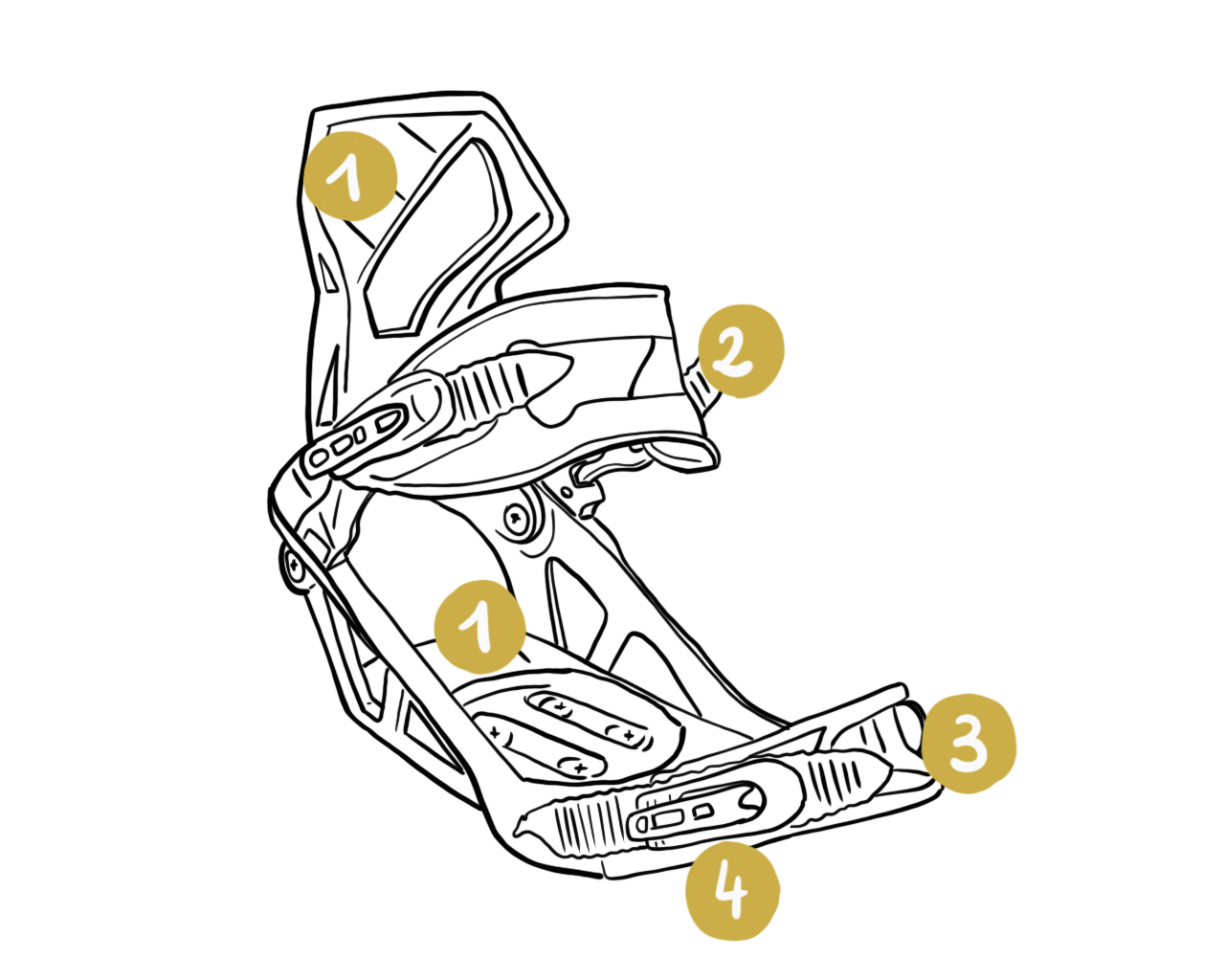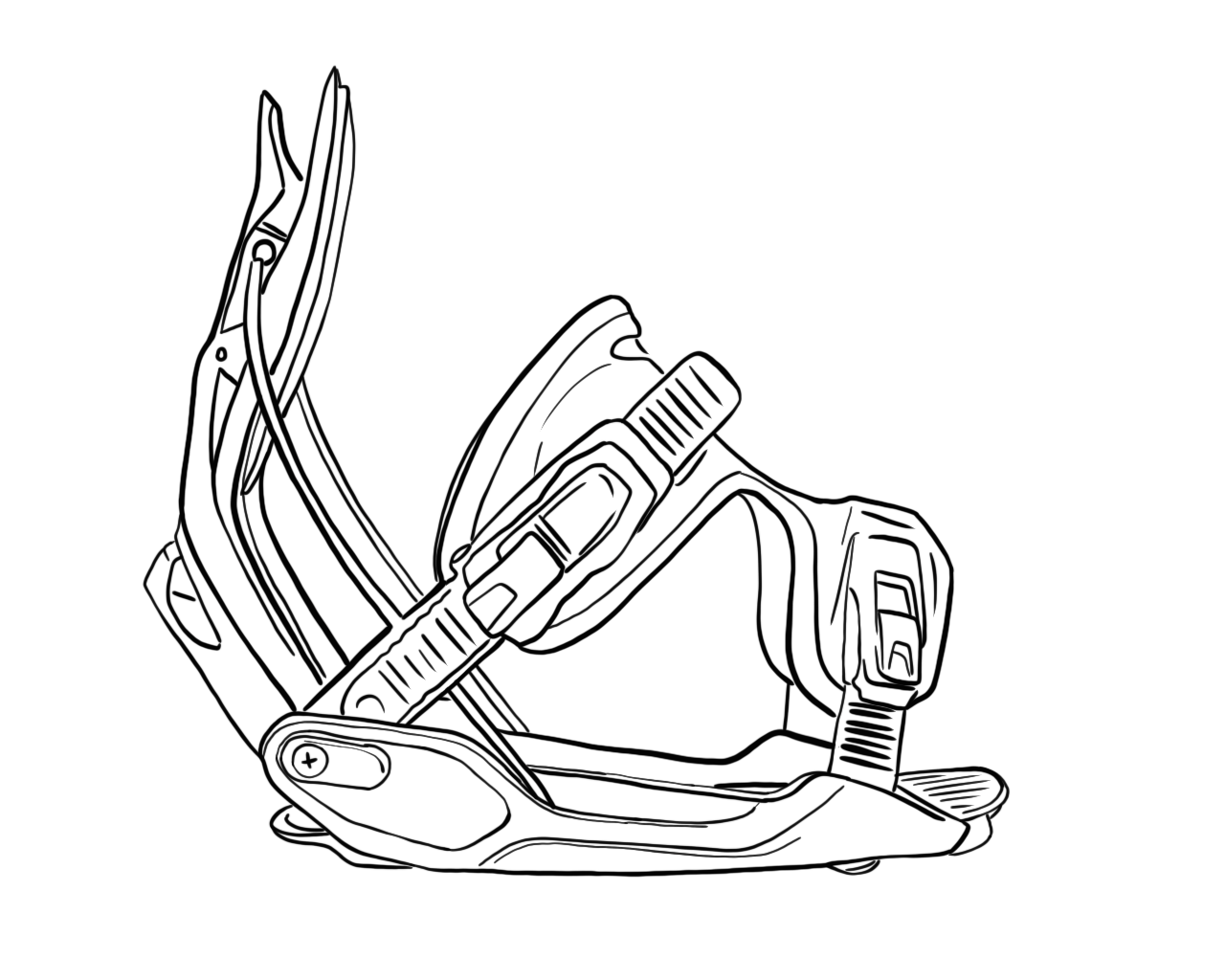1. Description of snowboard bindings
Most importantly, learn which components form the binding:
Bindings are a major part of the board and guarantee efficient glide and control of the snowboard, while providing support and comfort. In this article, learn about the elements that comprise the bindings, the various different types available, to help you choose the model that suits you best.
Most importantly, learn which components form the binding:

1. Spoiler
2. Base
3. Hooks
4. Sliders
The hooks fit into the sliders, enabling precise adjustment.

1. Foam cushioning pads-
2. Ankle strap
3. Toe strap
4. Gas Pedal for better support control

Disk and screw
A central disk is attached to the board binding with a screw and enables stance and the angle of binding opening to be adjusted

Forward lean adjuster
A part behind it enables the angle of the highback to be adjusted.
You’ll be opting for different models depending on your sports discipline. Also note that the flex of your bindings must align with the flex of your snowboard boots.
Here are some tips depending on your sports discipline:

You prefer freestyle
Freestylers tend to opt for bindings with short and flexible spoilers, which offer:
- A gentler and more tolerant ride style.
- Easy recovery when landing jumps.
- More freedom in tweaks and presses.

Freeride is what brings you alive
For freeriders, it’s best to choose bindings with a higher and more rigid highback, for:
- Precise control in deep powder and at high speed
- Response on steep terrain.

You’re a versatile rider
For versatile snowboarders who like to alternate between park, mogul fields and groomed slopes, we recommend medium flex bindings that adapt to all types of terrain.
Traditional snowboard bindings have an instep strap combined with a toe strap, providing very good support.
A variant exists, the "cap strap", which replaces the front strap: it not only covers the top of the toes, but also the tips. The cap strap offers the advantage of being very comfortable, while also supporting the front of the foot as efficiently as a classic strap does. By tightening the cap strap, the boot is firmly locked upwards while being pushed back as far as possible in the binding. This makes it possible to limit the overhang of the feet on the board as much as possible.

Traditional strap
The classic front strap positioned on top of the foot, at the toes.

Cap strap
The front "cap strap" which wraps around the tip of the foot, covers all the toes for enhanced support and comfort.
As their name suggests, quick bindings are ideal for those wanting to put on their snowboard boots quickly (the story of not keeping your fellow skiers waiting).
These bindings also offer the advantage of pre-adjusted tightening: once adjusted, no need to touch them again!

Rear entry bindings
On this type of binding, the spoiler tilts to allow the foot to slide into the binding easily.

Strapless bindings
Some models are fitted with a quick tightening system that does away with the need to use straps.

Splitboarding, or cross-country snowboarding, is an excellent way to discover the mountains on your own.
The goal? Go up in skins, down on the snowboard (the ultimate dream)!
Like cross-country skiing, splitboarding requires bindings specially designed for this use. These bindings differ by their capacity to adapt to two specific phases in the sport: the climb and the descent.
The climb (cross-country mode): In climb mode, the bindings detach from the board, allowing the splitboard to be divided into two separate skis. They are attached to rails or a pivoting system, offering certain freedom of movement at the front to make it easier to walk. This mode also allows you to raise your heel to facilitate forward movement on inclined terrain.
The descent (snowboard mode): Once at the summit, the two skis are reconnected again to form a snowboard. The bindings are repositioned in descent mode, providing support and control comparable to traditional snowboard bindings.
These bindings are often light and robust, to withstand cross-country conditions, and are fitted with simple yet effective locking systems to quickly switch from one mode to another.
Choose the size of your snowboard bindings according to the size of your boots.
At Decathlon, each binding has a guide equivalent. Snowboard binding sizes are rather generic:
➤ M (Medium): For sizes between 4 and 7.5
➤ L (Large): For sizes between 8 and 12.5
To choose the right size bindings, we recommend that you try them on with your snowboard boots.
Snowboarding is a sport that often attracts kids. And let's face it, seeing your little one on a snowboard is just too cute. But for their first experiences to be a success, their equipment needs to be suitable.
We offer two types of snowboard bindings for children, each corresponding to the size of their boots:

➤ XS = 30 – 33 (UK 11.5 - 1)
These XS bindings are suitable for shoe sizes 30 to 33 (UK 11.5 to 1).

➤ S = 34 – 38 (UK 1.5 - 5)
These S bindings are suitable for shoe sizes 34 to 38 (UK 1.5 to 5).
Now you have all the keys you need to make the best choice of snowboard bindings, whether for yourself or your child. It’s off to the slopes!